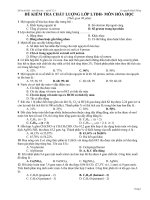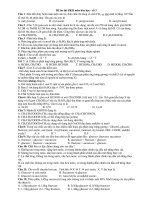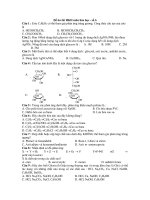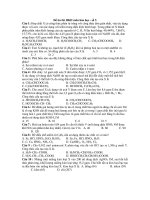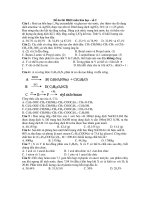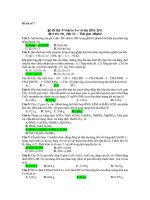Đề ôn thi thử môn hóa (860)
Bạn đang xem bản rút gọn của tài liệu. Xem và tải ngay bản đầy đủ của tài liệu tại đây (127.46 KB, 5 trang )
CHAPTER 103 Congenital Immunodeficiency
In addition to evaluating antibody quantity and quality, it is
essential to determine whether patients have normal B-cell numbers by evaluating lymphocyte subsets. The use of more detailed
B-cell immunophenotyping to evaluate B-cell development, the
presence of CD271 memory B cells, and the ability of memory B
cells to undergo immunoglobulin class switching has become
standard of care in many clinics, as it provides valuable diagnostic
and prognostic information.105
Flow cytometry testing to assess the expression of specific
proteins that are defective in B-cell and antibody deficiency
disorders—including BTK, CD40 ligand, CD40, ICOS, CD27,
BAFF receptor, and so on—can be performed in specialty laboratories and offer the ability to rapidly obtain a molecular diagnosis. This is typically supplemented by sequencing of specific
genes.
Diagnostic Testing: T Cells
T-cell testing begins with determination of whether the absolute
lymphocyte count is normal and assessment of lymphocyte subsets (CD41, CD81, CD561, CD162, CD191, Treg). Gross Tcell function can be ascertained beginning with T-cell proliferation assays. Vaccine responses with tetanus or diphtheria can also
be quantified. Diagnosis of specific T-cell defects are usually made
with flow cytometry to demonstrate alteration or absence of some
lymphocyte protein or focused genetic testing. Interrogation of
specific T-cell subsets and activation can also be used to identify
poorly functioning T-cell pathways.
Treatment of Immune System Disorders
Treatment: Complement
Patients with complement deficiency are susceptible to fulminant
sepsis and other deep-seated infections caused by encapsulated
organisms. For this reason, patients should be given a letter,
laminated card, medical alert bracelet/necklace, or Health Data
“Me” app that they can keep with them at all times with contact
information for their primary care physician and clinical immunologist and a message indicating that they have a complement
deficiency. The message should emphasize that there should be no
delay in giving parenteral antibiotics should they be ill. For patients who live at a distance from skilled medical care, consideration should be given to providing a dose of parenteral antibiotic,
such as ceftriaxone, that can be administered by the patient or a
family member when they become ill, before a lengthy trip to the
hospital. The efficacy of chronic prophylactic antibiotics to prevent infection in patients with complement deficiency is not well
studied and remains a significant question in this group of disorders. In addition to preparing for and treating infections, patients
should also be regularly screened for autoimmunity by history,
physical examination (i.e., blood pressure monitoring), and laboratory testing—including blood urea nitrogen, creatinine, and
urinalysis—to monitor for signs of glomerulonephritis because
this is a common autoimmune manifestation.
Treatment: Phagocytes
As noted earlier, management of phagocytic disorders revolves
around having a heightened suspicion for infections, aggressively
treating acute infections using antibiotics and G-CSF as needed
and developing a prophylaxis regimen that is both effective and
1227
reasonable from a patient standpoint. At times, patients continue
to have recurrent or severe infections despite these efforts and require more definitive therapy. As indicated earlier, HSCT has
been shown to be effective in many, but not all, phagocytic disorders. Gene therapy has been attempted for both X-linked CGD106
and for LAD-I,107 but neither has been particularly successful thus
far and at this point is considered to be experimental. Ongoing
research to address the challenges of gene therapy that are unique
to these two disorders is underway.
Treatment: B Cells and Antibodies
Immunoglobulin Replacement
In patients with antibody deficiency, replacement of IgG is critical
to maintaining health and preventing long-term complications
associated with recurrent infections. Immunoglobulin replacement therapy has been found to be effective when administered
intravenously (IVIg), subcutaneously (SCIg), and intramuscularly
(IMIg). US Food and Drug Administration–approved products
support administration via any of these routes. With that said,
because of significant discomfort associated with IMIg administration, this route is rarely used in North America. Most patients
are maintained on either IVIg or SCIg depending on patient
preference and provider recommendations related to each patient’s clinical need. Because the half-life of IgG in the circulation
is approximately 21 days under normal circumstances, IVIg is
typically administered every 3 to 4 weeks, providing high peak
levels followed by a decline over the ensuing weeks to a trough
before the next infusion. In contrast, SCIg is typically administered 1 to 2 times per week in smaller doses, providing a more
steady-state level of IgG in the circulation. IgG products are prepared from the pooled plasma collected from thousands of healthy
donors and therefore contain a broad range of antibodies. A reasonable starting dose of either IVIg or SCIg is 400 to 600 mg/kg
per month. This can be divided into the number of doses required
to administer the necessary monthly volume (IgG preparations
range in concentration from 5 g/100 mL [5%] to 20 g/100 mL
[20%]). In most patients, a trough IgG level of 600 mg/dL in the
blood is a reasonable initial minimum target. However, the dose
should then be adjusted to achieve a trough IgG level that prevents both acute infections and development of progressive lung
disease. There is evidence that, at least for bacterial pneumonia,
higher IgG trough levels are directly correlated with a decreased
risk of infection.108 Supplemental IgG is generally effective at
preventing lower respiratory tract infections (bronchitis and
pneumonia), but the response of upper tract disease (particularly
sinusitis) is more variable. Some patients have persistent sinus
symptoms that can be a significant clinical problem despite IgG
therapy. In these patients, the addition of prophylactic macrolide
therapy or increasing the frequency or dose of IgG infusions may
be beneficial.
Side effects with IVIg therapy are relatively common, occurring in up to 25% of treated patients.109 These include headaches, nausea, vomiting, chills, fatigue, fever, rash, and aseptic
meningitis. These can often be managed by changing the IgG
product being used; pretreating with diphenhydramine, acetaminophen, and corticosteroids before infusion; by augmenting hydration; or slowing the rate of infusion. Patients who
have persistent symptoms despite these measures will often
tolerate subcutaneous IgG supplementation. Side effects with
SCIg are rarer and consist mainly of transient local inflammatory reactions.
1228
S E C T I O N X I Pediatric Critical Care: Immunity and Infection
Prophylactic Antibiotics
It has been increasingly recognized that in many patients with
antibody deficiency, replacement of IgG (even to normal levels)
may not prevent all clinically significant infections. The addition
of prophylactic antibiotics has been used as an adjunct to IgG
therapy to try to improve control of infections and decrease
morbidity. Unfortunately, to date there have been no wellperformed studies that argue strongly either for or against the use
of prophylactic antibiotics to improve outcomes. Further studies
are needed to clarify the role of prophylactic antibiotics and to
define the optimal regimen.
stem cell sources have been tried, including matched bone marrow,
matched peripheral blood, cord blood, and haploidentical. Lastly, a
variety of prophylactic immunosuppressive regimens have been
used in the early posttransplant period to limit GVHD and prevent
graft rejection. Each option has advantages and disadvantages,
which has led to the spectrum of transplant regimens that have
been attempted for SCID. Current efforts are underway to assess
which regimens offer the best outcomes and lowest risk.110–113
Treatment: T Cells
Amaya-Uribe L, Rojas M, Azizi G, Anaya JM, Gershwin ME. Primary
immunodeficiency and autoimmunity: A comprehensive review.
J Autoimmun. 2019;99:52-72.
Bonilla FA, Barlan I, Chapel H, et al. International Consensus Document (ICON): Common Variable Immunodeficiency Disorders.
J Allergy Clin Immunol Pract. 2016;4:38-59.
Dotta L, Tassone L, Badolato R. Clinical and genetic features of Warts,
Hypogammaglobulinemia, Infections and Myelokathexis (WHIM)
syndrome. Curr Mol Med. 2011;11:317-325.
Frank MM. Complement deficiencies. Pediatr Clin North Am. 2000;47:
1339-1354.
Hanna S, Etzioni A. Leukocyte adhesion deficiencies. Ann N Y Acad Sci.
2012;1250:50-55.
Hussain A, Yu L, Faryal R, et al. TEC family kinases in health and
disease–loss-of-function of BTK and ITK and the gain-of-function
fusions ITK-SYK and BTK-SYK. FEBS J. 2011;278:2001-2010.
Lee WI, Torgerson TR, Schumacher MJ, et al. Molecular analysis of a
large cohort of patients with the hyper immunoglobulin M (IgM)
syndrome. Blood. 2005;105:1881-1890.
Mamcarz E, Zhou S, Lockey T, et al. Lentiviral gene therapy combined
with low-dose busulfan in infants with SCID-X1. N Engl J Med.
2019;380:1525-1534.
Notarangelo L, Casanova JL, Conley ME, et al. Primary immunodeficiency diseases: an update from the International Union of Immunological Societies Primary Immunodeficiency Diseases Classification
Committee Meeting in Budapest, 2005. J Allergy Clin Immunol.
2006;117:883-896.
Resnick ES, Moshier EL, Godbold JH, et al. Morbidity and mortality in
common variable immune deficiency over 4 decades. Blood. 2012;
119:1650-1657.
Rezaei N, Moazzami K, Aghamohammadi A, Klein C. Neutropenia and
primary immunodeficiency diseases. Int Rev Immunol. 2009;28:
335-366.
Segal BH, Leto TL, Gallin JI, et al. Genetic, biochemical, and clinical
features of chronic granulomatous disease. Medicine (Baltimore).
2000;79:170-200.
Kuhns DB, Alvord WG, Heller T, et al. Residual NADPH oxidase and
survival in chronic granulomatous disease. N Engl J Med. 2010;
363:2600-2610.
SCID was uniformly lethal in the first years of life until Good and
colleagues successfully reconstituted an affected infant with a
transplant of sibling bone marrow. Experience in subsequent years
has shown that patients with B-cell2positive SCID (IL2RG,
JAK3, IL7RA, etc.) readily reconstitute their T-cell deficiency but
may not develop significant B-cell chimerism. The reasons for this
are not entirely understood, but various hypotheses have been put
forward. From a practical standpoint, a lack of donor B-cell
engraftment may lead to a chronic need for IgG replacement
therapy even after transplant because patients may not be able
to mount sufficient antibody responses. Patients with B-cell2
negative SCID are more likely to have successful donor engraftment of both T- and B-cell lineages and more likely to recover full
humoral immune function.
One of the most significant challenges in the treatment of
SCID is that in the absence of family history, most patients come
to attention because of infections. These are most commonly
PJ pneumonia and severe viral infections (see earlier discussion).
PJ pneumonia can be treated but may lead to lung damage,
whereas viral infections may or may not be controllable. In addition, many SCID infants have significant diarrhea and weight loss
by the time they reach a transplantation center. Together, these
complications increase the risk of adverse outcomes during transplantation for SCID and have been the major impetus for adding
SCID to state newborn screening panels. Initial management
before transplantation involves aggressive supportive care, antimicrobials to treat any intercurrent infections (bacterial, viral, and
fungal), antimicrobial prophylaxis to prevent future infections,
and IgG replacement therapy.
There is significant debate about the best pretransplant conditioning regimen for patients with SCID to balance safety and efficacy. In general, those patients that have a matched sibling donor
receive no conditioning before receiving unmanipulated bone marrow. For other patients, a variety of conditioning regimens have
been tried, ranging from no conditioning to fully myeloablative
regimens. Similarly, a range of manipulated and unmanipulated
Key References
The full reference list for this chapter is available at ExpertConsult.com.
e1
References
1. Notarangelo L, Casanova JL, Conley ME, et al. Primary immunodeficiency diseases: an update from the International Union of Immunological Societies Primary Immunodeficiency Diseases Classification Committee Meeting in Budapest, 2005. J Allergy Clin Immunol.
2006;117:883-896.
2. Cossu F. Genetics of SCID. Ital J Pediatr. 2010;36:76.
3. Leiva LE, Zelazco M, Oleastro M, et al. Primary immunodeficiency
diseases in Latin America: the second report of the LAGID registry.
J Clin Immunol. 2007;27:101-108.
4. Frank MM. Complement deficiencies. Pediatr Clin North Am.
2000;47:1339-1354.
5. Hofer J, Janecke AR, Zimmerhackl LB, et al. Complement factor
H-related protein 1 deficiency and factor H antibodies in pediatric
patients with atypical hemolytic uremic syndrome. Clin J Am Soc
Nephrol. 2013;8:407-415.
6. Joseph C, Gattineni J. Complement disorders and hemolytic uremic
syndrome. Curr Opin Pediatr. 2013;25:209-215.
7. Westra D, Vernon KA, Volokhina EB, et al. Atypical hemolytic
uremic syndrome and genetic aberrations in the complement factor
H-related 5 gene. J Hum Genet. 2012;57:459-464.
8. Kawalec P, Holko P, Paszulewicz A, et al. Administration of conestat
alfa, human C1 esterase inhibitor and icatibant in the treatment of
acute angioedema attacks in adults with hereditary angioedema due
to C1 esterase inhibitor deficiency. Treatment comparison based on
systematic review results. Pneumonol Alergol Pol. 2013;81:95-104.
9. Patel NS, Fung SM, Zanichelli A, et al. Ecallantide for treatment of
acute attacks of acquired C1 esterase inhibitor deficiency. Allergy
Asthma Proc. 2013;34:72-77.
10. Cole SW, Lundquist LM. Icatibant for the treatment of hereditary
angioedema. Ann Pharmacother. 2013;47:49-55.
11. Walport MJ, Davies KA, Morley BJ, et al. Complement deficiency
and autoimmunity. Ann N Y Acad Sci. 1997;815:267-281.
12. Figueroa JE, Densen P. Infectious diseases associated with complement deficiencies. Clin Microbiol Rev. 1991;4:359-395.
13. Hanna S, Etzioni A. Leukocyte adhesion deficiencies. Ann N Y Acad
Sci. 2012;1250:50-55.
14. Farinha NJ, Duval M, Wagner E, et al. Unrelated bone marrow
transplantation for leukocyte adhesion deficiency. Bone Marrow
Transplant. 2002;30:979-981.
15. Thomas C, Le Deist F, Cavazzana-Calvo M, et al. Results of allogeneic bone marrow transplantation in patients with leukocyte adhesion deficiency. Blood. 1995;86:1629-1635.
16. Le Deist F, Blanche S, Keable H, et al. Successful HLA nonidentical
bone marrow transplantation in three patients with the leukocyte
adhesion deficiency. Blood. 1989;74:512-516.
17. Gulino AV, Moratto D, Sozzani S, et al. Altered leukocyte response
to CXCL12 in patients with warts, hypogammaglobulinemia, infections, myelokathexis (WHIM) syndrome. Blood. 2004;104:444-452.
18. Dotta L, Tassone L, Badolato R. Clinical and genetic features of
Warts, Hypogammaglobulinemia, Infections and Myelokathexis
(WHIM) syndrome. Curr Mol Med. 2011;11:317-325.
19. McDermott DH, Liu Q, Ulrick J, et al. The CXCR4 antagonist
plerixafor corrects panleukopenia in patients with WHIM syndrome. Blood. 2011;118:4957-4962.
20. Dale DC, Bolyard AA, Kelley ML, et al. The CXCR4 antagonist
plerixafor is a potential therapy for myelokathexis, WHIM syndrome. Blood. 2011;118:4963-4966.
21. Krivan G, Erdos M, Kallay K, et al. Successful umbilical cord blood
stem cell transplantation in a child with WHIM syndrome. Eur J
Haematol. 2010;84:274-275.
22. Segal BH, Leto TL, Gallin JI, et al. Genetic, biochemical, and clinical features of chronic granulomatous disease. Medicine (Baltimore).
2000;79:170-200.
23. Kuhns DB, Alvord WG, Heller T, et al. Residual NADPH oxidase
and survival in chronic granulomatous disease. N Engl J Med.
2010;363:2600-2610.
24. Seger RA. Hematopoietic stem cell transplantation for chronic
granulomatous disease. Immunol Allergy Clin North Am. 2010;
30:195-208.
25. Hussain A, Yu L, Faryal R, et al. TEC family kinases in health and
disease–loss-of-function of BTK and ITK and the gain-of-function
fusions ITK-SYK and BTK-SYK. FEBS J. 2011;278:2001-2010.
26. Dua J, Elliot E, Bright P, et al. Pyoderma gangrenosum-like ulcer
caused by Helicobacter cinaedi in a patient with X-linked agammaglobulinaemia. Clin Exp Dermatol. 2012;37:642-645.
27. Cuccherini B, Chua K, Gill V, et al. Bacteremia and skin/bone infections in two patients with X-linked agammaglobulinemia caused by
an unusual organism related to Flexispira/Helicobacter species. Clin
Immunol. 2000;97:121-129.
28. Turvey SE, Leo SH, Boos A, et al. Successful approach to treatment
of Helicobacter bilis infection in X-linked agammaglobulinemia.
J Clin Immunol. 2012;32:1404-1408.
29. Kainulainen L, Nikoskelainen J, Vuorinen T, et al. Viruses and bacteria in bronchial samples from patients with primary hypogammaglobulinemia. Am J Respir Crit Care Med. 1999;159:1199-1204.
30. Katamura K, Hattori H, Kunishima T, et al. Non-progressive viral
myelitis in X-linked agammaglobulinemia. Brain Dev. 2002;24:
109-111.
31. Misbah SA, Spickett GP, Ryba PC, et al. Chronic enteroviral meningoencephalitis in agammaglobulinemia: case report and literature
review. J Clin Immunol. 1992;12:266-270.
32. Quan PL, Wagner TA, Briese T, et al. Astrovirus encephalitis in boy
with X-linked agammaglobulinemia. Emerg Infect Dis. 2010;16:
918-925.
33. Lee WI, Torgerson TR, Schumacher MJ, et al. Molecular analysis of
a large cohort of patients with the hyper immunoglobulin M (IgM)
syndrome. Blood. 2005;105:1881-1890.
34. Cabral-Marques O, Schimke LF, Pereira PV, et al. Expanding the
clinical and genetic spectrum of human CD40L deficiency: the occurrence of paracoccidioidomycosis and other unusual infections in
Brazilian patients. J Clin Immunol. 2012;32:212-220.
35. Rodrigues F, Davies EG, Harrison P, et al. Liver disease in children
with primary immunodeficiencies. J Pediatr. 2004;145:333-339.
36. Jo EK, Kim HS, Lee MY, et al. X-linked hyper-IgM syndrome associated with Cryptosporidium parvum and Cryptococcus neoformans
infections: the first case with molecular diagnosis in Korea. J Korean
Med Sci. 2002;17:116-120.
37. Isam H, Al-Wahadneh A. Successful bone marrow transplantation in
a child with X-linked hyper-IgM syndrome. Saudi J Kidney Dis
Transpl. 2004;15:489-493.
38. Duplantier JE, Seyama K, Day NK, et al. Immunologic reconstitution following bone marrow transplantation for X-linked hyper IgM
syndrome. Clin Immunol. 2001;98:313-318.
39. Ferrari S, Giliani S, Insalaco A, et al. Mutations of CD40 gene cause
an autosomal recessive form of immunodeficiency with hyper IgM.
Proc Natl Acad Sci USA. 2001;98:12614-12619.
40. Imai K, Slupphaug G, Lee WI, et al. Human uracil-DNA glycosylase
deficiency associated with profoundly impaired immunoglobulin
class-switch recombination. Nat Immunol. 2003;4:1023-1028.
41. Revy P, Muto T, Levy Y, et al. Activation-induced cytidine deaminase
(AID) deficiency causes the autosomal recessive form of the hyperIgM syndrome (HIGM2). Cell. 2000;102:565-575.
42. Resnick ES, Moshier EL, Godbold JH, et al. Morbidity and mortality in common variable immune deficiency over 4 decades. Blood.
2012;119:1650-1657.
43. Bates CA, Ellison MC, Lynch DA, et al. Granulomatous-lymphocytic lung disease shortens survival in common variable immunodeficiency. J Allergy Clin Immunol. 2004;114:415-421.
44. Chase NM, Verbsky JW, Hintermeyer MK, et al. Use of combination chemotherapy for treatment of granulomatous and lymphocytic
interstitial lung disease (GLILD) in patients with common variable
immunodeficiency (CVID). J Clin Immunol. 2013;33:30-39.
45. Podjasek JC, Abraham RS. Autoimmune cytopenias in common
variable immunodeficiency. Front Immunol. 2012;3:189.
e2
46. Warnatz K, Voll RE. Pathogenesis of autoimmunity in common
variable immunodeficiency. Front Immunol. 2012;3:210.
47. van de Ven AA, Compeer EB, van Montfrans JM, et al. B-cell defects
in common variable immunodeficiency: BCR signaling, protein
clustering and hardwired gene mutations. Crit Rev Immunol.
2011;31:85-98.
48. Orange JS, Glessner JT, Resnick E, et al. Genome-wide association
identifies diverse causes of common variable immunodeficiency.
J Allergy Clin Immunol. 2011;127:1360-1367.
49. Bukowska-Strakova K, Kowalczyk D, Baran J, et al. The B-cell compartment in the peripheral blood of children with different types of
primary humoral immunodeficiency. Pediatr Res. 2009;66:28-34.
50. de Greef JC, Wang J, Balog J, et al. Mutations in ZBTB24 are associated with immunodeficiency, centromeric instability, and facial
anomalies syndrome type 2. Am J Hum Genet. 2011;88:796-804.
51. Moarefi AH, Chedin F. ICF syndrome mutations cause a broad
spectrum of biochemical defects in DNMT3B-mediated de novo
DNA methylation. J Mol Biol. 2011;409:758-772.
52. Arumugakani G, Wood PM, Carter CR. Frequency of Treg cells is
reduced in CVID patients with autoimmunity and splenomegaly
and is associated with expanded CD21lo B lymphocytes. J Clin
Immunol. 2010;30:292-300.
53. Melo KM, Carvalho KI, Bruno FR, et al. A decreased frequency of
regulatory T cells in patients with common variable immunodeficiency. PLoS ONE. 2009;4:e6269.
54. Genre J, Errante PR, Kokron CM, et al. Reduced frequency of
CD4(1)CD25(HIGH)FOXP3(1) cells and diminished FOXP3
expression in patients with common variable immunodeficiency: a
link to autoimmunity? Clin Immunol. 2009;132:215-221.
55. Yu GP, Chiang D, Song SJ, et al. Regulatory T cell dysfunction in
subjects with common variable immunodeficiency complicated by
autoimmune disease. Clin Immunol. 2009;131:240-253.
56. Fevang B, Yndestad A, Sandberg WJ, et al. Low numbers of regulatory
T cells in common variable immunodeficiency: association with
chronic inflammation in vivo. Clin Exp Immunol. 2007;147:521-525.
57. Lilic D, Sewell WA. IgA deficiency: what we should—or should
not—be doing. J Clin Pathol. 2001;54:337-338.
58. Bassett AS, McDonald-McGinn DM, Devriendt K, et al. Practical
guidelines for managing patients with 22q11.2 deletion syndrome.
J Pediatr. 2011;159:332-339.
59. McDonald-McGinn DM, Sullivan KE. Chromosome 22q11.2 deletion syndrome (DiGeorge syndrome/velocardiofacial syndrome).
Medicine (Baltimore). 2011;90:1-18.
60. Tomita-Mitchell A, Mahnke DK, Larson JM, et al. Multiplexed
quantitative real-time PCR to detect 22q11.2 deletion in patients
with congenital heart disease. Physiol Genomics. 2010;42A:52-60.
61. Ciupe SM, Devlin BH, Markert ML, et al. The dynamics of T-cell
receptor repertoire diversity following thymus transplantation for
DiGeorge anomaly. PLoS Comput Biol. 2009;5:e1000396.
62. Markert ML, Devlin BH, Chinn IK, et al. Thymus transplantation
in complete DiGeorge anomaly. Immunol Res. 2009;44:61-70.
63. Matsumoto T, Amamoto N, Kondoh T, et al. Complete-type DiGeorge syndrome treated by bone marrow transplantation. Bone
Marrow Transplant. 1998;22:927-930.
64. Goldsobel AB, Haas A, Stiehm ER. Bone marrow transplantation in
DiGeorge syndrome. J Pediatr. 1987;111:40-44.
65. Puck JM. Laboratory technology for population-based screening for
severe combined immunodeficiency in neonates: the winner is T-cell
receptor excision circles. J Allergy Clin Immunol. 2012;129:607-616.
66. Verbsky J, Thakar M, Routes J. The Wisconsin approach to newborn
screening for severe combined immunodeficiency. J Allergy Clin Immunol. 2012;129:622-627.
67. Yamada K, Tsukahara T, Yoshino K, et al. Identification of a high
incidence region for retroviral vector integration near exon 1 of the
LMO2 locus. Retrovirology. 2009;6:79.
68. Rans TS, England R. The evolution of gene therapy in X-linked severe combined immunodeficiency. Ann Allergy Asthma Immunol.
2009;102:357-362.
69. Hacein-Bey-Abina S, Von Kalle C, Schmidt M, et al. LMO2associated clonal T cell proliferation in two patients after gene
therapy for SCID-X1. Science. 2003;302:415-419.
69a.Mamcarz E, Zhou S, Lockey T, et al. Lentiviral gene therapy combined with low-dose busulfan in infants with SCID-X1. N Engl J
Med. 2019;380(16):1525–34.
70. O’Shea JJ, Husa M, Li D, et al. Jak3 and the pathogenesis of severe
combined immunodeficiency. Mol Immunol. 2004;41:727-737.
71. Roberts JL, Lengi A, Brown SM, et al. Janus kinase 3 (JAK3) deficiency:
clinical, immunologic, and molecular analyses of 10 patients and outcomes of stem cell transplantation. Blood. 2004;103:2009-2018.
72. Villa A, Notarangelo LD, Roifman CM. Omenn syndrome: inflammation in leaky severe combined immunodeficiency. J Allergy Clin
Immunol. 2008;122:1082-1086.
73. Booth C, Gaspar HB. Pegademase bovine (PEG-ADA) for the treatment of infants and children with severe combined immunodeficiency (SCID). Biologics. 2009;3:349-358.
74. Lee CR, McKenzie CA, Webster KD, et al. Pegademase bovine: replacement therapy for severe combined immunodeficiency disease.
DICP. 1991;25:1092-1095.
75. Gaspar HB. Gene therapy for ADA-SCID: defining the factors for
successful outcome. Blood. 2012;120:3628-3629.
76. Nekrep N, Fontes JD, Geyer M, et al. When the lymphocyte loses
its clothes. Immunity. 2003;18:453-457.
77. d’Hennezel E, Bin Dhuban K, Torgerson T, et al. The immunogenetics of immune dysregulation, polyendocrinopathy, enteropathy,
X linked (IPEX) syndrome. J Med Genet. 2012;49:291-302.
78. Torgerson TR, Ochs HD. Immune dysregulation, polyendocrinopathy, enteropathy, X-linked: forkhead box protein 3 mutations and lack
of regulatory T cells. J Allergy Clin Immunol. 2007;120:744-750.
79. Lucas KG, Ungar D, Comito M, et al. Submyeloablative cord blood
transplantation corrects clinical defects seen in IPEX syndrome.
Bone Marrow Transplant. 2007;39:55-56.
80. Rao A, Kamani N, Filipovich A, et al. Successful bone marrow transplantation for IPEX syndrome after reduced-intensity conditioning.
Blood. 2007;109:383-385.
81. Seidel MG, Fritsch G, Lion T, et al. Selective engraftment of donor
CD4125high FOXP3-positive T cells in IPEX syndrome after nonmyeloablative hematopoietic stem cell transplantation. Blood.
2009;113:5689-5691.
82. Ariga T. Wiskott-Aldrich syndrome; an X-linked primary immunodeficiency disease with unique and characteristic features. Allergol
Int. 2012;61:183-189.
83. Cleland SY, Siegel RM. Wiskott-Aldrich syndrome at the nexus of
autoimmune and primary immunodeficiency diseases. FEBS Lett.
2011;585:3710-3714.
84. Moratto D, Giliani S, Bonfim C, et al. Long-term outcome and lineagespecific chimerism in 194 patients with Wiskott-Aldrich syndrome
treated by hematopoietic cell transplantation in the period 1980-2009:
an international collaborative study. Blood. 2011;118:1675-1684.
85. Albert MH, Bittner TC, Nonoyama S, et al. X-linked thrombocytopenia (XLT) due to WAS mutations: clinical characteristics, longterm outcome, and treatment options. Blood. 2010;115:3231-3238.
86. Boztug K, Schmidt M, Schwarzer A, et al. Stem-cell gene therapy
for the Wiskott-Aldrich syndrome. N Engl J Med. 2010;363:
1918-1927.
87. Guggenheim R, Somech R, Grunebaum E, et al. Bone marrow
transplantation for cartilage-hair-hypoplasia. Bone Marrow Transplant. 2006;38:751-756.
88. de Miranda NF, Bjorkman A, Pan-Hammarstrom Q. DNA repair:
the link between primary immunodeficiency and cancer. Ann N Y
Acad Sci. 2011;1246:50-63.
89. Al-Muhsen S, Casanova JL. The genetic heterogeneity of Mendelian
susceptibility to mycobacterial diseases. J Allergy Clin Immunol.
2008;122:1043-1051.
90. Moilanen P, Korppi M, Hovi L, et al. Successful hematopoietic stem
cell transplantation from an unrelated donor in a child with interferon
gamma receptor deficiency. Pediatr Infect Dis J. 2009;28:658-660.
e3
91. Chantrain CF, Bruwier A, Brichard B, et al. Successful hematopoietic stem cell transplantation in a child with active disseminated
Mycobacterium fortuitum infection and interferon-gamma receptor
1 deficiency. Bone Marrow Transplant. 2006;38:75-76.
92. Filipovich AH. The expanding spectrum of hemophagocytic lymphohistiocytosis. Curr Opin Allergy Clin Immunol. 2011;11:512-516.
93. Casanova JL, Abel L, Quintana-Murci L. Human TLRs and IL1Rs in host defense: natural insights from evolutionary, epidemiological, and clinical genetics. Annu Rev Immunol. 2011;29:447-491.
94. Puel A, Cypowyj S, Marodi L, et al. Inborn errors of human IL-17
immunity underlie chronic mucocutaneous candidiasis. Curr Opin
Allergy Clin Immunol. 2012;12:616-622.
95. Kisand K, Lilic D, Casanova JL, et al. Mucocutaneous candidiasis
and autoimmunity against cytokines in APECED and thymoma
patients: clinical and pathogenetic implications. Eur J Immunol.
2011;41:1517-1527.
96. Puel A, Doffinger R, Natividad A, et al. Autoantibodies against IL17A, IL-17F, and IL-22 in patients with chronic mucocutaneous
candidiasis and autoimmune polyendocrine syndrome type I. J Exp
Med. 2010;207:291-297.
97. Oliveira JB, Bleesing JJ, Dianzani U, et al. Revised diagnostic criteria and classification for the autoimmune lymphoproliferative
syndrome (ALPS): report from the 2009 NIH International Workshop. Blood. 2010;116:e35-e40.
98. Oliveira JB, Gupta S. Disorders of apoptosis: mechanisms for autoimmunity in primary immunodeficiency diseases. J Clin Immunol. 2008;28(suppl 1):S20-S28.
99. Teachey DT. Autoimmune lymphoproliferative syndrome: new approaches to diagnosis and management. Clin Adv Hematol Oncol.
2011;9:233-235.
100. Teachey DT, Greiner R, Seif A, et al. Treatment with sirolimus results in complete responses in patients with autoimmune lymphoproliferative syndrome. Br J Haematol. 2009;145:101-106.
101. Boxer LA. How to approach neutropenia. Am Soc Hematol Educ
Program. 2012;2012:174-182.
102. Jirapongsananuruk O, Malech HL, Kuhns DB, et al. Diagnostic
paradigm for evaluation of male patients with chronic granulomatous
disease, based on the dihydrorhodamine 123 assay. J Allergy Clin
Immunol. 2003;111:374-379.
103. Vowells SJ, Sekhsaria S, Malech HL, et al. Flow cytometric analysis
of the granulocyte respiratory burst: a comparison study of fluorescent probes. J Immunol Methods. 1995;178:89-97.
104. Orange JS, Ballow M, Stiehm ER, et al. Use and interpretation of
diagnostic vaccination in primary immunodeficiency: a working
group report of the Basic and Clinical Immunology Interest Section of the American Academy of Allergy, Asthma & Immunology.
J Allergy Clin Immunol. 2012;130:S1-S24.
105. Wehr C, Kivioja T, Schmitt C, et al. The EUROclass trial: defining
subgroups in common variable immunodeficiency. Blood. 2008;111:
77-85.
106. Kang HJ, Bartholomae CC, Paruzynski A, et al. Retroviral gene
therapy for X-linked chronic granulomatous disease: results from
phase I/II trial. Mol Ther. 2011;19:2092-20101.
107. Bauer TR Jr, Hickstein DD. Gene therapy for leukocyte adhesion
deficiency. Curr Opin Mol Ther. 2000;2:383-388.
108. Orange JS, Grossman WJ, Navickis RJ, et al. Impact of trough IgG
on pneumonia incidence in primary immunodeficiency: a metaanalysis of clinical studies. Clin Immunol. 2010;137:21-30.
109. Pierce LR, Jain N. Risks associated with the use of intravenous immunoglobulin. Transfus Med Rev. 2003;17:241-251.
110. Teigland CL, Parrott RE, Buckley RH. Long-term outcome of
non-ablative booster BMT in patients with SCID. Bone Marrow
Transplant. 2013;48:1050-1055.
111. Buckley RH, Win CM, Moser BK, et al. Post-transplantation B cell
function in different molecular types of SCID. J Clin Immunol.
2013;33:96-110.
112. Grunebaum E, Roifman CM. Bone marrow transplantation using
HLA-matched unrelated donors for patients suffering from severe
combined immunodeficiency. Hematol Oncol Clin North Am.
2011;25:63-73.
113. Roifman CM, Grunebaum E, Dalal I, et al. Matched unrelated
bone marrow transplant for severe combined immunodeficiency.
Immunol Res. 2007;38:191-200.

